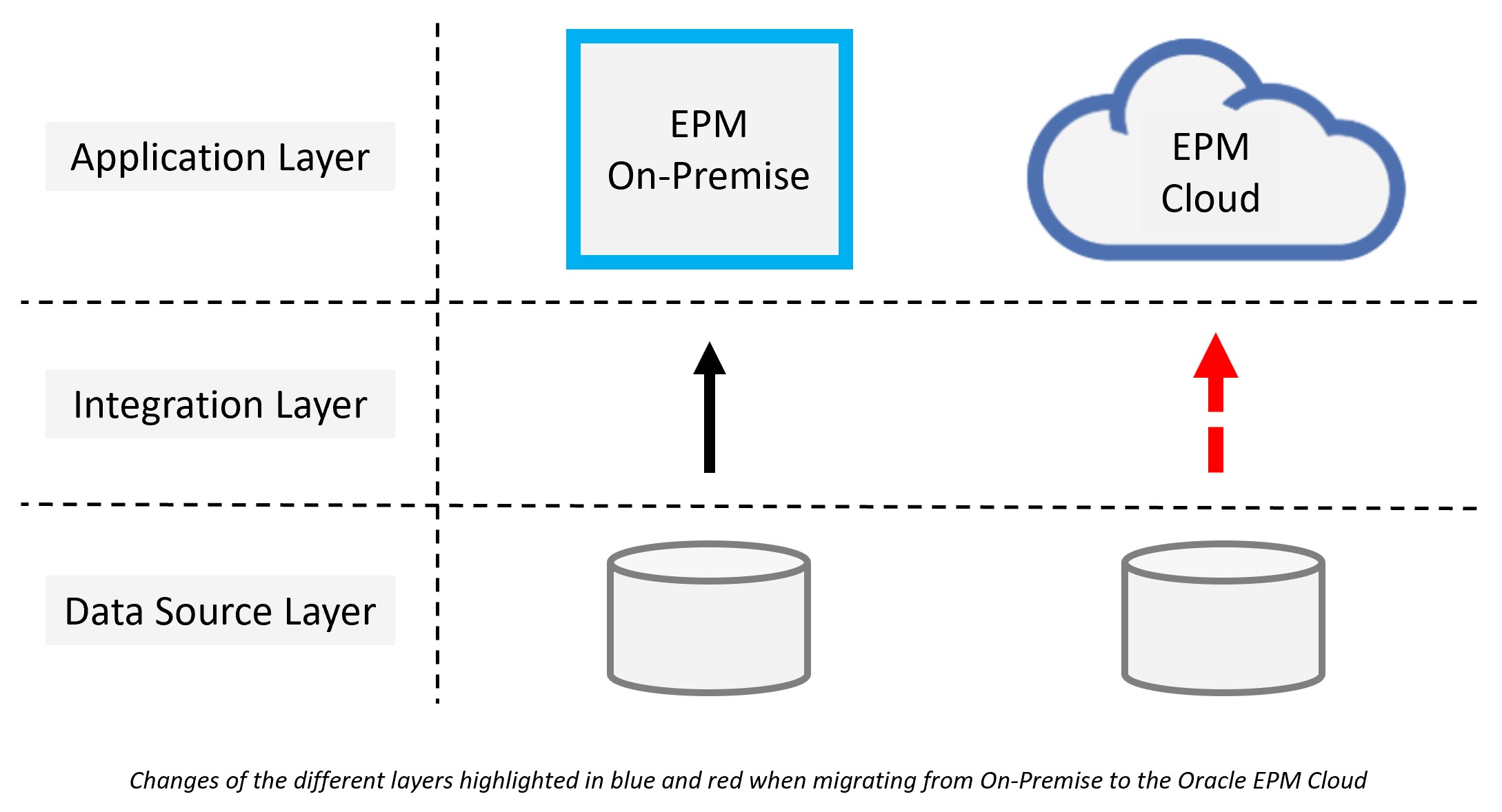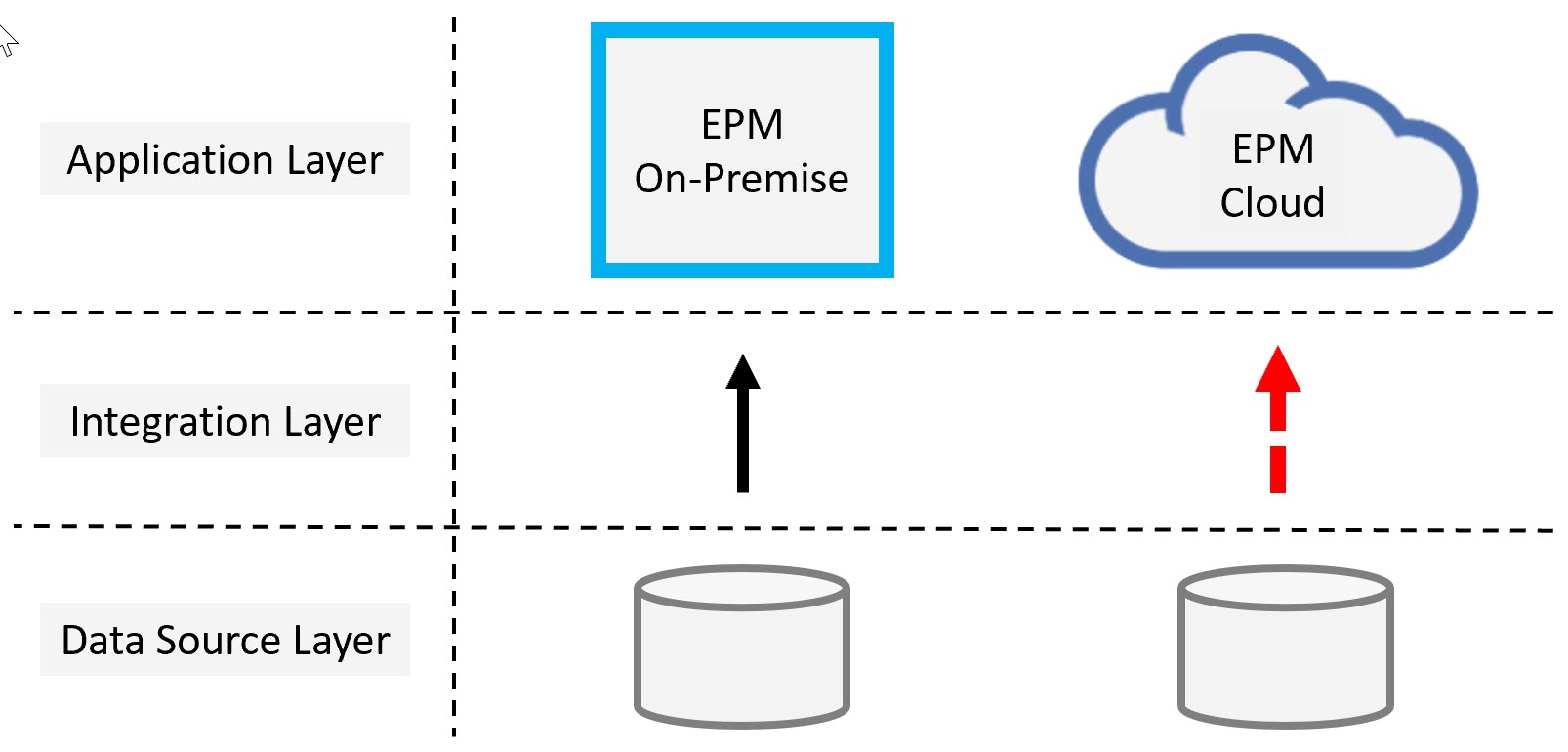Summary: This article provides examples of challenges that customers are facing when moving their Oracle EPM environment from on-premise to the cloud. Generally, it is only natural to put the primary focus on the features and functionality of the applications. Considering that the infrastructure (hardware, accessibility, control) is changing entirely when moving to the cloud: Are you sure you have the right focus? To make your migration efficient, ensuring it to be a great success you must shift your focus from application features to the integration & automation aspects of your environment.
1) Cloud migration projects often have one single focus, underestimating the real challenge

The initial focus of most EPM Cloud migration projects lies on the application layer as this is the most obvious change and affects the user community immediately – fair enough! But as you can see highlighted in blue in the picture above, the changes on the application layer are not the primary concern that cloud migration projects are facing. The most underestimated challenge is depicted by the red arrow within the Integration Layer. This arrow represents the integration and automation processes where many companies fail to dedicate the required attention. Exactly here lies the pitfall for a truly successful migration in time and budget, reducing maintenance and troubleshooting efforts while increasing productivity and ensuring compliance.
Going back to the Application Layer, the current focus that many organizations have: will I still have the same features and functionality?
Well, of course EPM teams need to perform their due diligence to ensure that the applications are still fully supporting their business requirements, but for the most part cloud applications provide the same features and functionality as their on-premise counterparts in some way or another. Considering Oracle’s Cloud First approach, cloud applications offer even greater value as this is the primary focus on innovation for Oracle, releasing new functionality on the cloud before it will be available on-premise.
The biggest change that is taking place is not as visible as it does not impact the behavior of the application: your infrastructure is changing 100%. Surprisingly this often seems to be an afterthought: first we are going to look at the applications – and oh, almost forgot about integration and automation but that’s pretty straight forward, right? Actually, this is where the biggest challenges are created. While Oracle provides interfaces and APIs to interact with the backend of your applications, organizations will miss out on having full access to their environment as well as a vast number of capabilities for integration and automation.
2) Challenges for Integration and Automation
One of the biggest mistakes made during a cloud migration project is to underestimate the effort to migrate the integration and automation processes. The problem is that the infrastructure is changing 100%! Many ETL tools and other automation vendors are advertizing that they can integrate just as well with the cloud, but this is, in almost every case, an empty promise.
One of the main reasons for this and biggest caveats of moving to the cloud is that you loose control over your infrastructure – let`s be honest: it is just not “your infrastucture” anymore. All you are doing is “renting/leasing” it. Therefore your access is heavily restricted. Of course there are mechanisms to interact with the infrastructure, but rather than working directly on the servers Oracle provides an API to interact with the servers. (Of course these limitations are not unique to Oracle and you will find these in pretty much every similar SaaS-based product offering as well.)
In a similar way integration and automation are impacted and the methods to interact are heavily based on APIs or wrappers which come in the form of a client that needs to be installed on-premise (like EPMAutomate).
The result for customers: sub-par solutions which cause a lot of frustration and feel like taking two big steps backwards rather taking one step forward towards innovation.
Here are some of the things we’ve heard from EPM customers:
- Building tailored integration and automation processes cost a lot more time and money than we anticipated
- If a process fails, it is very time-consuming to identify the root cause
- Our ETL tool is like a blackbox and we are unable to fully own our EPM processes
- We are excited about moving to the cloud, but still need to connect to on-premise to trigger our automation processes
- Our automation process is a script with 100s of lines and I’m not comfortable owning it
(one could make the case that FDMEE provides some viable options, but it often still requires a significant amount of scripting)
3) Blueprints for a successful migration project
Let’s step away from the obvious challenges and take a look at how integration and automation should work.
- Processes should be seamlessly integrated
- Integrating new data sources should be straight-forward without requiring special skills or overcoming massive technical hurdles
- Automation processes should be robust and error handling should be intuitive and easy to implement
- Custom scripting should be avoided or at least limited
- Detailed logs should be readily available and provide transparency
Bottom line: data integration and automation should be an enabler rather than an inhibitor of transforming EPM processes!
Considering the massive changes in regards to infrastructure and integration/automation, EPM teams should question whether the available integration tools are the best fit for their system landscape which has started to change and will continue to do so dramatically over the next years.
4) ICE Cloud: the straight-forward path to a successful Cloud migration
Conventional integration and automation tools have not fully been adapted to the changed requirements and quite frankly these tools have not been created for EPM in the first place – in fact this is true for both on-premise EPM as well as Cloud. Therefore, organizations should look at new offerings which are disrupting the market for integration and automation in the EPM field.
ICE Cloud is a revolutionary platform that was purpose-built for Oracle EPM and BI. It stands for Integrated, Compliant and Efficient Cloud and is an Integration & Automation platform that gives control back to the Finance & Accounting teams to build a fully integrated and compliant EPM Cloud system that is easy to maintain, operate and troubleshoot.
ICE Cloud is your guarantor for a smooth Cloud migration, giving back control to Finance and Accounting to manage their application environment.
ICE Cloud accomplishes this by
- Providing a user-friendly drag & drop interface which allows a functional admin to build sophisticated integration and automation processes in just a few minutes – without writing a single line of code
- Using simply-to-use adapters (instead of complex ETL or extraction processes): building integrations becomes easy and there is no need to create flat files or complex integrations; ICE Cloud integrates your applications seamlessly, whether on-premise or in the cloud
- Ensuring Audit & SOX Compliance requirements: every execution is captured with relevant metrics and all application changes are tracked automatically
- Informing admins and users with out-of-the-box email notifications that provide detailed execution status and possibly steps for resolving errors
Learn more about ICE Cloud at www.fintechinnovations.com
ICE Cloud provides a straight path to resolve the challenges described above and is easy to implement. Our customers are experiencing significant productivity gains which allow them to focus on adding value rather than spending most of their time managing a disconnected system that requires many manual steps.
Contact us today to schedule your ICE Cloud demo and take a big step towards a truly successful cloud migration.


